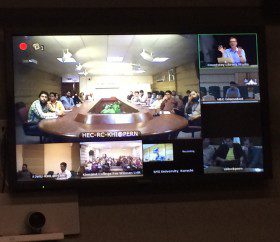SAI hosted its first webinar of the semester on September 15 titled ‘Using Cell Phones to Study Behavior: From Individuals to Entire Nations’ with JP Onnela, Assistant Professor of Biostatistics, Department of Biostatistics, Harvard T.H. Chan School of Public Health (HSPH). Using videoconference software provided by the Higher Education Commission of Pakistan, the webinar engaged with six universities in South Asia.
Onnela shared his research as part of the Onnela Lab at HSPH, which studies statistical network science and digital phenotyping. Onnela explained that progress in science has always been driven by data. However, in recent years there has been a dramatic increase in data volume and type – ‘Big Data.’
Data can unlock powerful information about human life. There are now more mobile phones in use than there are people in the world, providing increasingly rich data in real-world contexts. This also means that biology, the study of life, has become an information/computational science as opposed to a lab science, according to Onnela.
Using the data from cell phones, Onnela is helping make public health more data-driven. People are connected – and therefore our health is connected.
Historically, it has been difficult to collect social network data on a large scale – of entire towns and nations. Up until 10 years ago, researchers like Onnela could only study the ‘tip of the iceberg.’ By studying social networks through cell phone data, networks can now be visualized in many different ways through topology, and help understand public health issues like the spread of disease and epidemics.
Onnela’s team uses Call Detail Records (CDRs), communication metadata that has been anonymized. These records are used for understanding 1) network structures that connect people – through text messages and call logs; and 2) spatial mobility of different individuals.
Cell phones are a powerful tool for public health. Onnela also discussed his work with digital phenotyping, which uses moment-by-moment quantification of individuals using data from smartphones. Onnela’s team has developed an app to take millions of data points and turn them into meaningful biomedical knowledge and clinical insights. For example, a patient with depression could self-report her daily feelings, thoughts, and symptoms throughout the day on her phone, rather than the doctor having to rely on her memory.
Onnela was part of the Harvard team that studied social networks at India’s Kumbh Mela festival in 2013, the world’s largest gathering, where over 80 million people came to Allahabad. The team set out to answer this question: Can we study the event through the lens of cell phone data? Onnela hopes that this type of research can be used in other situations, including helping governments and event organizers predict the behavior of crowds, traffic patterns, and stampedes.
Watch the webinar (preferable browser is Internet Explorer).

